Fact Sheet FS678
Planting Site and Soil Preparation
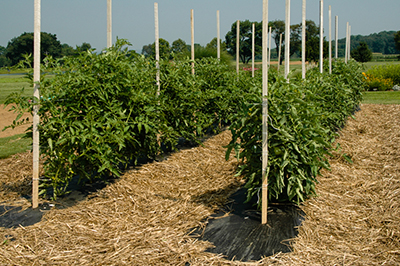
Tomato culture demo.
Tomatoes need at least 8 hours of direct sun each day. The area should be well-drained, and free from the competition of tree and shrub roots. If possible, plant tomatoes in an area where tomatoes, peppers, eggplants, and potatoes have not grown for at least two years to help avoid soil-borne disease problems.
Preparations for any crop should begin with a soil test. Test envelopes and soil sampling instructions can be obtained at your local county Rutgers Cooperative Extension office. Soil testing forms and instructions can also be obtained online from the Rutgers Soil Testing Laboratory. The soil test report will indicate the pH of the soil, the level of major nutrients, and recommend the appropriate amendments. In the absence of a soil test, add about 3 to 4 pounds of a 5-10-5 fertilizer per 100 square feet or a 2-inch layer of well-rotted compost. If you haven't limed your soil in a few years add 5 to 10 pounds of limestone per 100 square feet. This will keep the soil's pH in the range of 6.0–6.5 which is optimum for tomato growth. Incorporate lime and fertilizer into the top 4 to 6 inches of the soil. Adding organic matter such as compost, or well-rotted manure will improve the soil's nutrient and water-holding capacity.
Variety Selection
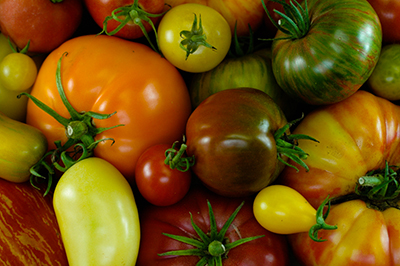
Tomato varieties.
There are thousands of tomato varieties from which to select. Choosing among these varieties is partly a matter of personal taste and experience, although there are also some important cultural considerations.
Seed catalogs usually list a number beside each variety. This number indicates the number of days to maturity from the time of transplanting (not from the time of seeding). This is an approximation; the actual time will depend on your local growing conditions. The number should be used as a guide for choosing early, mid-season, and late varieties.
Varieties are also identified as being determinate, semi-determinate, and indeterminate. Determinate plants produce many short branches ending in flower clusters with a very brief harvest. They are seldom used in the garden except as early varieties, since most people want a long harvest season.
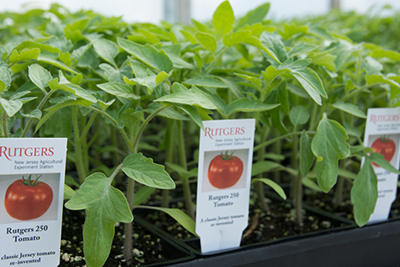
Rutgers 250 tomato transplants.
Indeterminate plants are large and will continue to grow all season long. They may grow more than 6 feet tall if given support and produce fruit until frost. Semi-determinate varieties are more compact than indeterminate plants but will also produce heavy crops until frost. For the home gardener, semi-determinate and indeterminate varieties are usually recommended for long, continuous harvests.
The variety name may also be followed by several letters. These letters indicate if that particular variety is resistant to certain diseases. The letter V indicates resistance to Verticillium wilt; F resistance to Fusarium wilt; N to nematodes; T to Tobacco Mosaic Virus; and to EB Early Blight. It is highly recommended to choose varieties with resistance to important soil-borne diseases such as EB, V, and F, especially if tomatoes are planted in the same area each year. There are pictures and descriptions of many different tomato varieties in the Rutgers NJAES tomato variety database.
| Season | Variety | Days to Maturity | Vine Type | Disease Resistance | Fruit Size (oz.) |
|---|---|---|---|---|---|
| Early | Early Girl | 50 | Indeterminate | V,F | 4 |
| Early Goliath | 58 | Semi-determinate | V,F,N | 8 | |
| Fourth of July | 49 | Indeterminate | V,F,N,T | 4 | |
| Moreton | 70 | Indeterminate | V | 8 | |
| Red Deuce | 72 | Determinate | V,F,T | 10 | |
| Sunstart | 66 | Determinate | V,T | 10 | |
| Mid-Season | Better Boy | 75 | Indeterminate | V,F,N | 12 |
| BHN 589 | 75 | Determinate | V,F,TMV | 7 | |
| Big Beef | 70 | Indeterminate | V,F,N,TMV | 10 | |
| Big Boy | 78 | Indeterminate | 16 | ||
| Celebrity | 72 | Semi-determinate | V,F,N,T | 10 | |
| Jet Star | 72 | Indeterminate | V,F | 10 | |
| Mountain Magic | 66 | Indeterminate | V,F,EB | 2 | |
| Red Defender | 75 | Determinate | V,F,T | 8 | |
| Rutgers 250 | 74 | Semi-determinate | 10 | ||
| Scarlet Red | 73 | Determinate | V,F | 12 | |
| Sunbrite | 75 | Determinate | V,F | 10 | |
| Late Season | Ramapo | 85 | Indeterminate | V,F | 12 |
| Heirloom | Plum | Cherry | Grape |
|---|---|---|---|
| Arkansas Traveler | Health Kick | Jasper | Juliet |
| Box Car Willie | Mariana | Matt's Wild Cherry | Scarlet Sunrise |
| Brandywine Red | Plum Crimson | Sun Gold | Smarty |
| Eva Purple Ball | Plum Dandy | Sugar Snack | Tami G |
| Green Zebra | San Marzano | Sun Sugar | |
| Mister Stripey | Viva Italia | Sweet 100 | |
| Mortgage Lifter | |||
| Prudens Purple | |||
| Snow White | |||
| Yellow Pear |
Planting
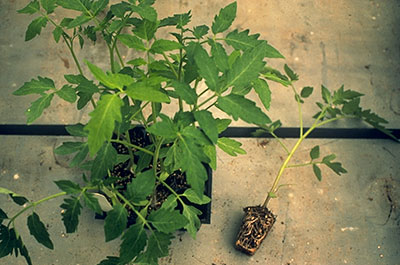
Tomato plant.
Transplants can be purchased at a local garden center or started indoors by the gardener. When buying transplants, it's best to look for dark green seedlings which are short and sturdy. Avoid tall, leggy, yellowish plants. Transplants may have flowers but avoid those having small green fruit if they are in a six pack or small pot. Plants with immature fruits usually remain small and are low-yielding.
Gardeners who want to start their own seedlings at home have a much wider selection of varieties to choose from but special care is required if the gardener is to be successful (see FS523, Grow Your Own Vegetable and Flower Seedlings). Start your own seedlings about 6 to 8 weeks before you expect to plant outside. Use a sterile growth media (available in garden centers), ensure adequate lighting and humidity, and maintain temperatures in the range of 70°F during the day and 65°F at night. If plants become elongated and spindly, increase the amount and intensity of light they receive.
Transplant tomatoes outside when all danger of frost is past. Planting too early stresses plants due to cool air and soil temperatures. In addition, tomatoes are very sensitive to frost and will be killed by temperatures below 32°F. If you must plant early, protect plants with row covers, hot caps, plastic containers, or some other means.
Tomatoes, unlike other vegetables, do better when the stem is slightly buried. Roots will form along the stem, establishing a stronger root system. Plants should be set so the soil level is just below the lowest leaves. When planting, place rows 3 to 4 feet apart. Tomatoes grown on stakes or in cages can be placed 1 ½ to 2 feet apart within rows. If plants are allowed to sprawl on the ground, allow 3 feet between plants.
Growth and Culture
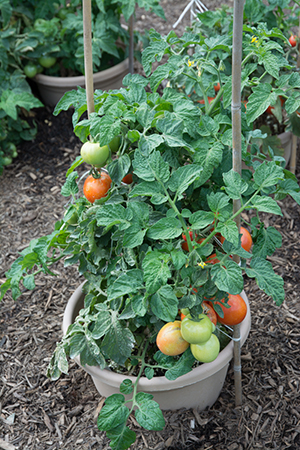
Container tomatoes.
Once outdoors, tomato plants should be kept well-watered. They will need at least 1 inch of water each week either from rainfall or watering. Watering should be done slowly and deeply so the plants form deep roots.
To keep your plants healthy, side dress the tomatoes with about 1/2 cup of 5-10-5 fertilizer per plant and work shallowly into the top inch of soil. This should be done when tomato fruits are about 1 inch in diameter and again when the first fruit is harvested. Water soluble fertilizers applied weekly or biweekly can also be used as an alternative to granular fertilizers. Follow the directions on the label for use rates and schedule.
Weeds can be controlled by shallow cultivation around the tomato plants or by applying mulch. Mulch can also help hold moisture in the soil and modify soil temperatures. The selection of mulches that can be used around tomato plants includes straw, salt hay, dried grass clippings, and black plastic. Straw, salt hay, and grass clippings should be applied in 3- to 4-inch layers after the soil has warmed up in the late spring. Some extra caution is needed with grass clippings to make sure they were not treated with an herbicide (if the lawn has been treated with an herbicide, wait at least three cuttings before using the clippings as a mulch). Black plastic sold in garden centers is an effective mulch which has the added benefit of warming the soil. These plastic sheets can be laid over the ground and secured by placing soil over the edges. Tomato transplants can then be planted through holes cut in the plastic.
Training Techniques
There are three training methods for tomatoes in the home garden, all of which have their advantages and disadvantages. The first method is to allow the plants to sprawl directly on the ground without any support. This requires little additional work after planting since the tomatoes are not pruned or tied. It is not recommended for home gardens, however, since plants grown this way require a lot of space. In addition, plants grown on the ground are more likely to be bothered by soil-borne diseases and pests. If this technique is to be used, select determinate or semi-determinate varieties which will stay smaller and use mulch to prevent fruit from lying on the soil.
A second technique is to grow tomatoes in wire cylinders or cages. These cages can be purchased at garden centers or built at home. Wire mesh for homemade cages should have 4 to 6 inch openings to allow access to pick the ripe fruit. Cattle fencing or wire mesh used in reinforcing concrete works well. A piece 6 feet in length can be bent into a cylinder about 22 inches in diameter. These cylinders should be placed around each plant and anchored with stakes driven into the ground around the base. As the plants grow, they will be supported by the mesh. Any shoots which grow through the mesh should be gently pushed back into the cylinder. With this technique, the fruit is kept off the ground and away from some soil diseases that cause rot, while at the same time kept shaded and protected from sunscald.
Staking tomatoes is the third major cultivation technique and is the most labor-intensive. Stakes for tomatoes should be at least 1 ½ inches square, about 6 feet in length, and set 8 to 10 inches into the soil. The general idea when staking tomatoes is to limit the tomatoes to one or two vigorous stems by pruning. This is done by removing all of the "sucker shoots" which grow from the area between a leaf stem and the main stem. Suckers are easiest to remove by snapping them off before they reach 3 inches in length. The tomato plants can be tied to their stakes using soft string or thin strips of cloth in the shape of a figure 8 tied at the stake end. The stem will be in one loop of the figure 8 and the stake in the other. This method allows the tomato stem to grow without being damaged. The advantages to staking tomatoes include slightly earlier and larger fruit. Disadvantages include decreased total yields from each plant and fruit which is more susceptible to blossom end rot and sunscald. If a lot of tomato plants are to be grown, consider using the stake and weave method (see: FS1102, The Stake and Weave Training System for Tomatoes in the Home Garden).
Common Tomato Disorders
The following is a list of tomato problems caused by environmental stress:
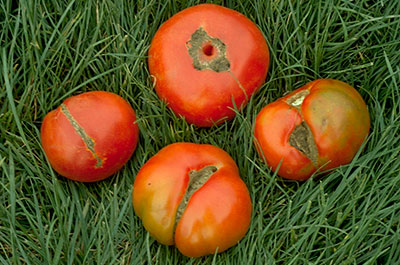
Catfacing.
Blossom end rot: The blossom end of the fruit blackens and becomes leathery. The problem is caused by a lack of calcium in the fruit due to variable soil moisture conditions. Prevention involves keeping the soil evenly moist. Mulches are helpful in this regard. Fruit is perfectly safe to eat.
Sunscald: This appears as a white or yellowish spot on the part of the fruit facing the sun. To minimize this problem, never remove mature foliage from the plant.
Catfacing: Misshapen, severely deformed fruit, more common on the large-fruited or early varieties, resulting from incomplete pollination of the tomato flower due to cold conditions when flowering. To minimize damage, plant tomatoes after weather warms, avoid using large-fruited varieties, and harden tomato transplants by limiting water—not by lowering temperatures. Catfaced tomatoes are safe to eat.
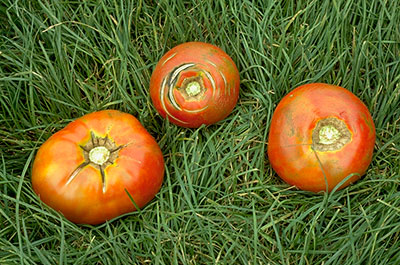
Fruit Cracking.
Fruit cracking: May be expressed as either concentric cracks around the stem end of the fruit or as radial cracks radiating from the stem scar. Cracking usually occurs after a heavy rainfall following dry conditions. Keep soil evenly moist and avoid fluctuating soil moisture conditions.
All foliage, no fruit: This condition usually results from too much nitrogen in the soil, heavy rainfalls, or air temperatures too high (>90°F) or too low (<55°F) causing flower abortion. Unfortunately, you only have control over the added nitrogen. Avoid using fresh manure or fertilizer with a high nitrogen content (more than three times the level of Phosphorus or Potassium).
Mention or display of a trademark, proprietary product, or firm in text or figures does not constitute an endorsement by Rutgers Cooperative Extension and does not imply approval to the exclusion of other suitable products or firms.
Photos courtesy of Peter Nitzsche.
January 2021
Copyright © 2024 Rutgers, The State University of New Jersey. All rights reserved.
For more information: njaes.rutgers.edu.
Cooperating Agencies: Rutgers, The State University of New Jersey, U.S. Department of Agriculture, and Boards of County Commissioners. Rutgers Cooperative Extension, a unit of the Rutgers New Jersey Agricultural Experiment Station, is an equal opportunity program provider and employer.

